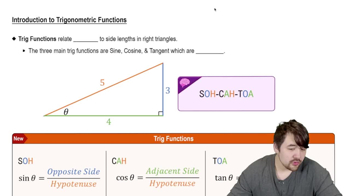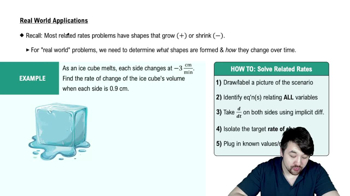Table of contents
- 0. Functions7h 52m
- Introduction to Functions16m
- Piecewise Functions10m
- Properties of Functions9m
- Common Functions1h 8m
- Transformations5m
- Combining Functions27m
- Exponent rules32m
- Exponential Functions28m
- Logarithmic Functions24m
- Properties of Logarithms34m
- Exponential & Logarithmic Equations35m
- Introduction to Trigonometric Functions38m
- Graphs of Trigonometric Functions44m
- Trigonometric Identities47m
- Inverse Trigonometric Functions48m
- 1. Limits and Continuity2h 2m
- 2. Intro to Derivatives1h 33m
- 3. Techniques of Differentiation3h 18m
- 4. Applications of Derivatives2h 38m
- 5. Graphical Applications of Derivatives6h 2m
- 6. Derivatives of Inverse, Exponential, & Logarithmic Functions2h 37m
- 7. Antiderivatives & Indefinite Integrals1h 26m
- 8. Definite Integrals4h 44m
- 9. Graphical Applications of Integrals2h 27m
- 10. Physics Applications of Integrals 2h 22m
4. Applications of Derivatives
Related Rates
Problem 3.R.115
Textbook Question
A jet flying at 450 mi/hr and traveling in a straight line at a constant elevation of 500 ft passes directly over a spectator at an air show. How quickly is the angle of elevation (between the ground and the line from the spectator to the jet) changing 2 seconds later?
 Verified step by step guidance
Verified step by step guidance1
First, understand the scenario: The jet is flying horizontally at a constant speed of 450 mi/hr, which needs to be converted to feet per second for consistency with the elevation given in feet. Use the conversion factor: 1 mile = 5280 feet.
Next, set up the relationship between the angle of elevation \( \theta \), the horizontal distance \( x \) from the spectator to the jet, and the constant elevation \( h = 500 \) ft. The tangent of the angle \( \theta \) is given by \( \tan(\theta) = \frac{h}{x} \).
Differentiate the equation \( \tan(\theta) = \frac{h}{x} \) with respect to time \( t \) to find \( \frac{d\theta}{dt} \). Use implicit differentiation: \( \sec^2(\theta) \cdot \frac{d\theta}{dt} = -\frac{h}{x^2} \cdot \frac{dx}{dt} \).
Determine \( \frac{dx}{dt} \), the rate at which the horizontal distance \( x \) is changing. Since the jet is moving at 450 mi/hr, convert this speed to feet per second: \( \frac{450 \times 5280}{3600} \) ft/s.
Finally, substitute the known values into the differentiated equation. At \( t = 2 \) seconds, calculate \( x \) using \( x = \text{speed} \times t \). Then, solve for \( \frac{d\theta}{dt} \) using the values of \( x \), \( h \), and \( \frac{dx}{dt} \).
 Verified video answer for a similar problem:
Verified video answer for a similar problem:This video solution was recommended by our tutors as helpful for the problem above
Video duration:
10mPlay a video:
Was this helpful?
Key Concepts
Here are the essential concepts you must grasp in order to answer the question correctly.
Related Rates
Related rates involve finding the rate at which one quantity changes in relation to another. In this problem, we need to determine how the angle of elevation changes as the jet moves horizontally. This requires applying the concept of derivatives to relate the rates of change of the angle and the horizontal distance traveled by the jet.
Recommended video:

Intro To Related Rates
Trigonometric Functions
Trigonometric functions, particularly tangent in this context, relate angles to the ratios of sides in right triangles. The angle of elevation can be expressed using the tangent function, where the opposite side is the height of the jet and the adjacent side is the horizontal distance from the spectator to the jet. Understanding how to manipulate these functions is crucial for solving the problem.
Recommended video:

Introduction to Trigonometric Functions
Differentiation
Differentiation is the process of finding the derivative of a function, which represents the rate of change of a quantity. In this scenario, we will differentiate the expression for the angle of elevation with respect to time to find how quickly the angle is changing. This requires applying implicit differentiation to relate the changes in the angle to the changes in the horizontal distance and height.
Recommended video:

Finding Differentials
Related Videos
Related Practice





